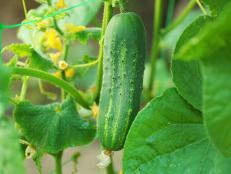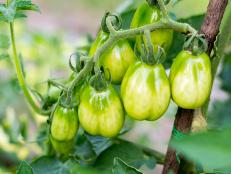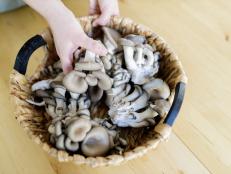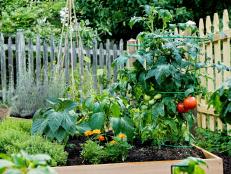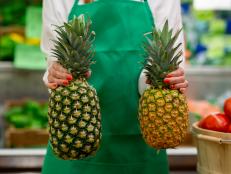20+ Tips for Shopping at a Farmers Market
When it comes to seasonal pleasures, it’s tough to top the sensory overload of a farmers market. Make the most of your visits with these in-the-know tips.

Chicago Botanic Garden at ChicagoBotanic.org
Farmers markets serve up a smorgasbord of homegrown produce, artisanal foods and local meats. Shopping your local market lets you experience the joy of locavore living — and opens wide the door to connecting with the source of your food. It’s nirvana for foodies, gardeners and pretty much anyone who likes to eat. I’m a farmers market fanatic, planning vacations and business trips around local market schedules. I’ve never met a farmers market I didn’t like.
Make the most of your weekly excursions to find the freshest food by following these farmers market shopping tips, gleaned from farmers, market organizers and my own expeditions to markets from Alaska to Florida — and everywhere in between.
Review the rules. Every farmers market has its own protocols. Some markets are early, while others don’t kick into gear until after 5 p.m. In some regions, drive-through markets are the rage, especially in light of the pandemic. Many farmers team pre-orders with curbside pick-up. Some even offer local delivery. If you haven’t been to your local market for a while, check to make sure you’re ready for any changes.
Go early. For the best selection, get there when the market opens, especially if local chefs shop the stalls for their menus. Learn what items are in short supply or disappear fastest in your area — and snap them up. This often includes things like peas, seasonal berries, heirloom tomatoes, corn and local stone fruits.
Brave bad weather. The next best time to go shopping is when the weather isn’t ideal. A sun-drenched day draws out the crowds, while foggy, misty or even rainy weather keeps a lot of folks away. If the market is short on shoppers, vendors may be willing to make deals to move their goods. Shopping on slow days also helps keep sellers in business and willing to return.

Williams-Sonoma.com
Come prepared. Vendors may provide plastic bags for produce, and often they prefer to use them because it’s easier than putting produce into your bag. Even so, plan to bring your own bags to help carry all the goods you’ll be buying, especially if you’re getting melons, corn or other heavy items. Have a cooler ready in the car in the heat of summer. If you’re buying fresh fish, chicken or meat, a cooler is a necessity in any season. Having a way to clean your hands (wet wipes or a bottle of sudsy water) is another good idea because fresh-picked veggies may have a little dirt on them.
Scoop the loop. Take time to walk the length of the market before buying. Vendors change, and in large markets, stalls in certain sections often rotate on a weekly or bimonthly basis. Doing a walkabout lets you discover who has the produce you want at the best price.
Carry cash. Typically cash is king at farmers markets, although more vendors are accepting cashless transactions. It really depends on your locality. In most cases, it’s a good idea to bring small bills and change — the farmers will love you for it. Stash quarters, singles and five dollar bills in a jar, and you’ll always be ready for market day.

Massachusetts Office of Travel and Tourism/massvacation.com
Look for the unusual. A farmers market is the place to find unique produce, like these heirloom Chioggia beets. Take advantage of your market to explore different versions of familiar foods, such as purple carrots or potatoes, black radish or rainbow chard (top of page).
Buy what’s in season. The beauty of a farmers market is that you can get the freshest food, often picked within the last few hours. Learn what’s in season when in your area to ensure you’re always choosing the freshest produce. For instance, if you live in a northern region and you see citrus at the market, it’s safe to assume that the vendor picked it up from a wholesaler or packing house and is reselling. Avoid those stalls, unless a vendor shares non-local produce origins with signs like “Georgia peaches, just arrived.”
Talk to farmers. This is your chance to get to know — and support — a local farmer, so take advantage. Ask them about foods you’re not familiar with, how crops are grown or harvested, and storage or cooking advice. Learn when they might have a particular item you like or how long it will be available. The best time to talk to farmers is early before the crowds arrive.
Sign up. Many farmers send weekly emails or texts to let customers know what’s available at the market that week. They often share tasty recipes or invaluable storage advice.
Embrace non-organic. Not all farmers who grow organically are certified by the U.S. Department of Agriculture. Why? The certification process is costly and requires a mountain of recordkeeping. If farmers aren’t certified organic, they might advertise as “natural” or “sustainable.” Just because a stand isn’t organic doesn’t mean their produce is chemical-laden. Get to know your favorite farmers and the types of growing practices they use. Don’t be afraid to ask them what they spray on their crops (even organic farmers spray crops).

Chicago Botanic Garden at ChicagoBotanic.org
Find the bargains. The secret to finding the best deals usually hinges on one of three things. First, look for stalls that sell seconds — produce that’s too small, ugly or otherwise unable to command full price. Unless you need picture-perfect produce, the uggo’s usually taste just as good as top-of-the-line beauties. Second, visit smaller stalls. They often have better prices than their bigger competitors. Third, ask if your market lets vendors reduce prices at the end of the day. If so, you can score amazing deals as farmers want to lighten their loads going home.
Buy in bulk. Another way to get a good price is to buy in bulk. Many farmers will sell produce in bulk if you ask. The right time to buy in bulk is if you’re putting up the fresh fare in some way (canning, freezing, drying) or if you have the ideal storage conditions at home. For example, orchard-fresh apples last a long time in a fridge set to the correct temperature, rewarding your family with a hearty crunch well into winter.
Plan to preserve. Some flavors are too good not to preserve, either for your family or holiday gifts. It’s not hard to can. The toughest part is figuring out what you want to preserve — and how. Do you want to buy fresh basil to freeze pesto, or do you want to dry your own herbs? Or perhaps try your hand at salsa or spaghetti sauce, or whip up a batch of jam or jelly.
16 Winning Ways to Preserve Fruit 15 Photos
From freezing to canning to drying, find out what to put up and how to do it to make your harvest last.
Learn what ripe looks like. If you’re unsure, ask farmers for help in choosing a ripe item. They’re usually happy to teach you how to choose a good piece of produce, whether it’s a peach, pumpkin or pepper. Buy produce at the stage of ripeness to suit your use. If you’re not going to cut a cantaloupe for a few days, tell the farmer and have them help you select a just-right melon. Don’t forget to ask them for advice on how to properly store items to encourage or halt ripening.

Massachusetts Office of Travel and Tourism/massvacation.com
Take the kids. A farmers market is a great place to take kids to let them learn more about where food comes from. It’s also a sneaky way to get them to try veggies — they’re more likely to try something they helped choose, or unusual items, like purple green beans that magically turn green when cooked. For older kids, plan a farmers market scavenger hunt, turning the visit into a contest to find certain things, such as a yellow tomato, red pepper or white pumpkin.
Shop like a chef. Many people hit the farmers market just like they approach shopping at the store: sticking to a list. Chefs go with an open mind, looking to find what’s freshest and seasonal this week. They buy those items, and then build a menu from there. It’s not hard to do this if you stock your larder with simple mainstays like pasta, rice, tortillas and beans. Fresh veggies plus any of those items can quickly be turned into a tasty, nutritious meal.
Avoid overbuying. Mountains of brightly colored veggies, buckets of flowers and tables of produce are seductive, making it easy to buy too much. Balance how much time you have to cook with what your family will consume in a week and buy accordingly.
Set a spending cap. It’s easy to blow through a wad of cash at the farmers market. Preserve your food budget by establishing a spending limit and sticking to it. If you know you’re going to want to buy something in bulk, ask the farmer ahead of time how much that costs so you can budget (and bring enough cash).

Chicago Botanic Garden at ChicagoBotanic.org
Don’t forget flowers. Plan to pick up fresh flowers at the farmers market. These blossoms will have a terrific vase-life and help improve your mood while reducing stress (studies have proven this). Some flower growers offer CSA flowers, which ensures you’ll get the blooms you crave no matter when you arrive at the market.
Try the meat. Many farmers markets feature locally raised meat, such as chicken, beef and pork. Before buying a large amount of meat to fill your freezer, purchase a small amount for an in-home taste test so you’ll know the quality of meat you’re getting.
Make a list. Once you get home, as you load things into the fridge, make a list of what you purchased. Post it somewhere prominent to make sure you don’t forget what’s stashed away. You can even make it a family competition to mark off items — whoever notices you’re serving a farmer’s market item can cross it off the list.








